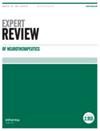Rimegepant and atogepant: novel drugs providing innovative opportunities in the management of migraine.
IF 3.4
2区 医学
Q2 CLINICAL NEUROLOGY
引用次数: 0
Abstract
INTRODUCTION Rimegepant and atogepant, two innovative oral medications for the treatment of migraine, are gaining prominence in the treatment of migraine. However, outside of specialist headache centers, these novel medications remain subjectively underutilized. While multiple rationales exist describing their underutilization, a leading factor is the complexity and clinical flexibility attributed to the individual members of the gepant medication class. AREAS COVERED This review provides a brief review of the current uses, common adverse events, and potential areas of future clinical innovation attributed to rimegepant and atogepant. A database search for the term 'Rimegepant OR Atogepant' was completed, yielding 240 individual results. Following multiple rounds of assessment that aimed to determine relevance of each individual result, 42 studies were included in the synthesis of this review. EXPERT OPINION Rimegepant and atogepant are exciting medications that demonstrate significant clinical innovation within the field of migraine therapy. While current indications are clear, data is lacking regarding the future expanded roles of these medications. Current areas of potential therapeutic innovation for rimegepant and atogepant include the pediatric population, in pregnancy and breastfeeding, in cluster headache and post-traumatic headache, and in patients that previously discontinued calcitonin gene-related peptide (CGRP) monoclonal antibody (mAb) therapy.Rimegepant 和 atogepant:为偏头痛治疗提供创新机会的新型药物。
简介瑞格潘和阿托格潘这两种治疗偏头痛的创新口服药物在偏头痛的治疗中日益受到重视。然而,在头痛专科中心之外,这些新型药物的主观使用率仍然偏低。本综述简要回顾了利美昔班和阿托昔班的当前用途、常见不良事件以及未来临床创新的潜在领域。在数据库中搜索 "Rimegepant 或 Atogepant",共获得 240 条结果。专家观点利美君和阿托格潘是令人振奋的药物,它们在偏头痛治疗领域展示了重大的临床创新。虽然目前的适应症很明确,但缺乏有关这两种药物未来扩大作用的数据。目前,利美君和阿托格潘的潜在治疗创新领域包括儿科人群、孕期和哺乳期、丛集性头痛和创伤后头痛,以及曾停止降钙素基因相关肽(CGRP)单克隆抗体(mAb)治疗的患者。
本文章由计算机程序翻译,如有差异,请以英文原文为准。
求助全文
约1分钟内获得全文
求助全文
来源期刊

Expert Review of Neurotherapeutics
Medicine-Neurology (clinical)
CiteScore
7.00
自引率
2.30%
发文量
61
审稿时长
4-8 weeks
期刊介绍:
Expert Review of Neurotherapeutics (ISSN 1473-7175) provides expert reviews on the use of drugs and medicines in clinical neurology and neuropsychiatry. Coverage includes disease management, new medicines and drugs in neurology, therapeutic indications, diagnostics, medical treatment guidelines and neurological diseases such as stroke, epilepsy, Alzheimer''s and Parkinson''s.
Comprehensive coverage in each review is complemented by the unique Expert Review format and includes the following sections:
Expert Opinion - a personal view of the data presented in the article, a discussion on the developments that are likely to be important in the future, and the avenues of research likely to become exciting as further studies yield more detailed results
Article Highlights – an executive summary of the author’s most critical points
 求助内容:
求助内容: 应助结果提醒方式:
应助结果提醒方式:


